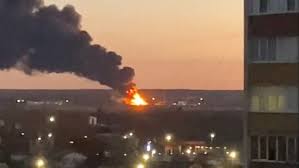In a significant escalation of rhetoric and military strategy, Russia has revised its nuclear doctrine in response to the growing threat of long-range attacks from Ukraine. This move comes as drone strikes hit hard, demonstrating Ukraine’s increasing capability to strike deep within Russian territory. The recent devastating attacks on Russian ammunition depots have highlighted the changing nature of warfare and the critical role of unmanned aerial vehicles in modern conflicts.
Russia’s Nuclear Sabre-Rattling Intensifies
Dmitry Medvedev, deputy head of Russia’s National Security Council, announced that President Vladimir Putin has outlined new approaches to the country’s nuclear weapons policy. The updated doctrine now considers “a massive launch and crossing of our border with enemy aerospace weapons, including aircraft, missiles and UAVs” as potential grounds for nuclear retaliation. This policy shift appears tailored to address the specific threat posed by Ukraine’s long-range strike capabilities.
The doctrine also introduces a clause stating that aggression against Russia by a non-nuclear state supported by nuclear powers would be considered a joint attack. This directly implicates Ukraine’s Western allies, including nuclear-armed nations like the United States, the United Kingdom, and France. The move seems designed to refresh Russia’s nuclear deterrent, as officials have reportedly expressed concern that previous threats had lost their impact due to overuse.
Ukraine’s Devastating Drone Strikes on Russian Ammunition Depots
As Drone Strikes Hit Hard, Russian Logistics Suffer
Ukraine has demonstrated the potency of its domestically produced drones with recent attacks on Russian ammunition depots in Tikhoretsk and Toropets. These strikes, occurring 300km and 500km from Ukrainian-controlled territory respectively, showcase Kyiv’s ability to conduct long-range operations without relying on Western-supplied missiles.
The attack on Tikhoretsk reportedly destroyed 2,000 tonnes of munitions, while Estonian intelligence estimates that the Toropets strike may have obliterated three months’ worth of Russian ammunition supplies – approximately 750,000 shells. Satellite imagery confirms extensive damage to these facilities, underlining the effectiveness of Ukraine’s drone warfare capabilities.
These successful operations have exposed vulnerabilities in Russia’s rear supply depots, which have been less protected due to Western restrictions on Ukraine’s use of foreign-supplied weapons for strikes within Russian territory. The Institute for the Study of War suggests this has allowed Russia to optimize its logistics at the cost of operational security.
The Drone Arms Race and International Response
Both Ukraine and Russia are rapidly scaling up their drone production capabilities. Ukrainian Defense Minister Rustem Umyerov announced plans to produce “several million” drones in the coming year, far surpassing their initial goal of one million. In response, Putin has stated that Russia aims to increase its drone production nearly tenfold in 2024.
The international community is taking notice of this drone-centric warfare. The European Parliament recently voted to lift restrictions on Ukraine’s use of Western weapons, a move that prompted strong reactions from Russian officials, including warnings of potential nuclear escalation.
To support Ukraine’s defense industry growth, the European Union has proposed a €35 billion loan, part of a larger G7 pledge. This funding would significantly expand Ukraine’s defense manufacturing capabilities, potentially shifting the balance of power in the ongoing conflict.
As drone strikes hit hard and reshape the battlefield, both Russia and Ukraine are adapting their strategies and capabilities. Russia’s nuclear posturing and Ukraine’s successful long-range attacks mark a new phase in the conflict, with unmanned aerial vehicles playing an increasingly central role. The international community’s response, including potential changes to weapons restrictions and significant financial support for Ukraine, could further alter the dynamics of this evolving war. As both sides invest heavily in drone technology, the conflict enters a new era of remote warfare with far-reaching implications for global security.
Related News
















